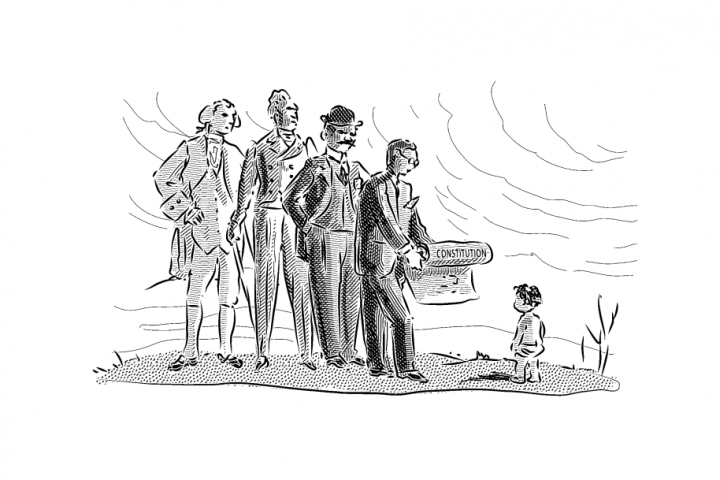Books Reviewed
A review of A Citizen’s Guide to Terrorism and Counterterrorism, by Christopher C. Harmon
After directing his first film, The Dancer Upstairs (2002), about terrorism in Peru, John Malkovich commented in an interview that “It’s no surprise that the head of Reuters popularized the phrase ‘One man’s terrorist is another man’s freedom fighter,’ because only a journalist could come up with something so utterly facile and idiotic, and actually obscene.” “Every day,” he continued, “somewhere in the world terrorists will murder people who have nothing to do with their cause, to promote their cause, and that’s something the world is starting to grapple with now.”
In A Citizen’s Guide to Terrorism and Counterterrorism, Christopher Harmon does for his readers something like what Malkovich did in that interview, sweeping aside the cheap moral relativism that often confuses public discussions of terrorism by reminding readers of terrorism’s foundation in bad politics. Understanding the bad politics behind terrorism, and the need for a grand strategy to respond to it, is the core of any effective counterterror strategy.
Literary treatments of bomb-throwing terrorism, artfully exploring the political thought that informs terror, date back at least to Fyodor Dostoevsky's The Possessed (1872) and Joseph Conrad’s The Secret Agent (1907). Significant academic attention to the politics of terror would not appear until the 1970s, when scholars of law and national security recognized the similar motives and tactics of Algeria’s FLN, the Viet Cong, Palestinian nationalist groups, the Ku Klux Klan, Germany’s Red Army Faction, and California’s own Symbionese Liberation Army, to name just a few.
But much of that scholarship, translated into college textbooks, hasn’t been especially helpful; it may be critical of terrorist violence but is usually unwilling—or perhaps intellectually unable—to criticize terrorists’ political goals. The conventional political science textbook treatment of terrorism is a value-free approach focused on the violence. But terror groups are inherently political organizations—simply put, they aim to rule. They are emphatically not value-free moral relativists—they use violence against existing governments and civilians to bring down the existing government and replace it with one of their own design. Harmon’s inspiring and handy volume recognizes the political character of terrorism and, unlike the standard textbooks, points readers toward an understanding of how “good and free government, supported by a sober and determined citizenry,” is an essential element of counterterror strategy.
* * *
Bin Laden may be dead, Dr. Zawahiri on the lam, and al-Qaeda scattered but, as Harmon argues, we remain vulnerable to a broad movement, not just a single organization. And he usefully reminds us that these are not altogether new problems. The radical Islamists who pose the present danger have different objectives from the revolutionaries who bombed Wall Street in 1920 or the Aryan Nations terrorists who started operating from northern Idaho in the 1970s, but they are all inspired by a political motivation antithetical to liberty and equal justice under law.
Harmon holds the Major General Matthew C. Horner Chair of Military Theory at Marine Corps University. At the core of his book is a plan of action and a primer on grand strategy. Al-Qaeda and its allies think, plan, and operate in terms of grand strategy, he argues, and citizens of a free republic need to turn the tables on them and do likewise. Grand strategy is no arcane preserve for elite military theorists; it is simply “the art and process by which all the tools of a nation’s power are brought to bear” against a threat—in this case al-Qaeda. Regrettably, as Harmon notes, our latest source of strategic guidance—President Obama’s 2011 National Strategy for Counterterrorism—spends rather too much time implying that bin Laden’s demise means al-Qaeda is in a tailspin, and citizens can rest easy. Not by a long shot.
* * *
But what, specifically, needs to be done? In his lengthiest chapter, Harmon offers eleven points of action, from denying terrorists their foreign sanctuaries and deepening our own intelligence analysis to keeping the moral high ground (i.e., no room for torture). The most surprising point is his strong emphasis on improved civics education—as a matter of grand strategy. He strongly argues the need to educate both ourselves and peoples in the developing countries (which terror groups see as fertile ground) in the principles and practice of good government. This is no cheap democracy promotion, but an education in freedom without which all the other anti-terror measures are pointless.
Terror organizations don’t last forever, and the endgame for terrorists isn’t usually pretty—a final dramatic showdown against military power as in the case of the Liberation Tigers of Tamil Eelam in Sri Lanka in 2009, or organizational decapitation, as in the case of the Red Army Faction in Germany in the 1970s and beyond. Or sometimes a terror group will morph into a political party, as did El Salvador’s FMLN, with a few leaders surviving the transition.
But Harmon reminds us that terror organizations can win the day—Lenin’s Bolsheviks and the Khmer Rouge, to name the most deadly. Al-Qaeda’s spawn in the northern half of Africa and throughout the Middle East and the Indian subcontinent show every sign of continuing to maim, kidnap, and murder in order to terrorize their neighbors into political submission. Whether they succeed or not will depend decisively on how those countries’ citizens and our own respond to the “one man’s terrorist” question. In this urgent business of educating ourselves to be freedom fighters, Christopher Harmon’s Citizen’s Guide is an essential weapon.



